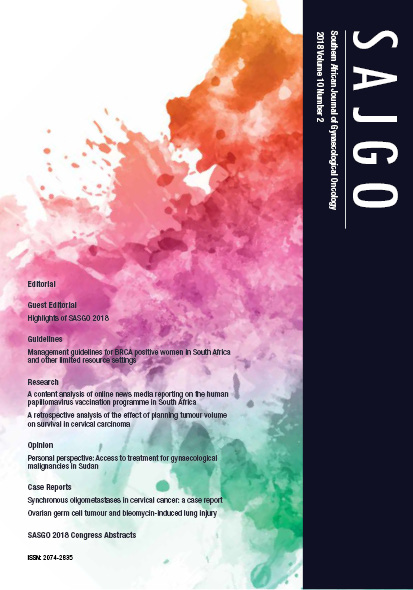A retrospective analysis of the effect of planning tumour volume on survival in cervical carcinoma
Keywords:
cervix carcinoma, tumour volume, radiotherapy, survivalAbstract
Introduction: Locally advanced stages of invasive cervical cancer (ICC) are associated with poor outcomes; factors influencing survival include increased tumour volume. In resource constrained settings access to diagnostic imaging with CT and MRI is limited. Alternative methods of establishing tumour volume can be defined with use of the planning target volume (PTV) delineated prior to radiotherapy. The aim of this study is to determine whether increased PTV size impacted on overall survival in a cohort of cervical cancer patients with Stage IIB/IIIB disease who completed radical radiotherapy. Materials and methods: A retrospective analysis was undertaken of patients with histologically confirmed Stage IIB/IIIB ICC treated with radical radiotherapy. Exclusion criteria included patients who did not complete prescribed radiotherapy and brachytherapy. Demographic and treatment details were collected. Planning target volumes were retrieved. Kaplan–Meier analysis was used to calculate the overall survival rate. A multivariate Cox proportional hazard model was derived to assess associations with all-cause mortality. Results: A total of 71 patients met the inclusion/exclusion criteria. The median PTV was 653 cc. On univariate analysis factors significantly associated with a lower overall survival included HIV positivity and the presence of hydronephrosis. Increased PTV size paradoxically showed a trend to improved overall survival. On multivariant analysis HIV status, advanced stage, hydronephrosis and a smaller PTV were significantly related to higher all-cause mortality. Conclusion: It is concluded that, when using planning target volumes, the hypothesis that larger volumes impact on overall survival was disproved. A larger cohort and more accurate methods of determining tumour volume, including PET/CT, will be considered in future prospective studies. (Full text available online at www.medpharm.tandfonline.com/ojgo) South Afr J Gynaecol Oncol 2018; DOI: 10.1080/10.1080/20742835.2018.153146Downloads
Published
Issue
Section
License
South African Journal of Gynaecological Oncology (SAJGO) Copyright is held by South African Society of Gynaecologic Oncology (SASGO). Copyright of the articles is held by the authors. The work is licensed under a Creative Commons Attribution-Non-Commercial Works 4.0 South Africa License (CC BY NC). Material submitted for publication in the SAJGO is accepted provided it has not been published elsewhere. The SAJGO does not hold itself responsible for statements made by the authors. The opinions expressed in this publication are those of the authors. They do no purport to reflect the opinions or views of SASGO or its members.
